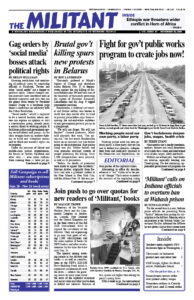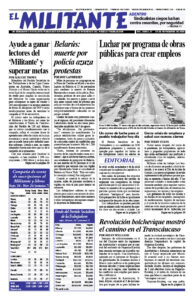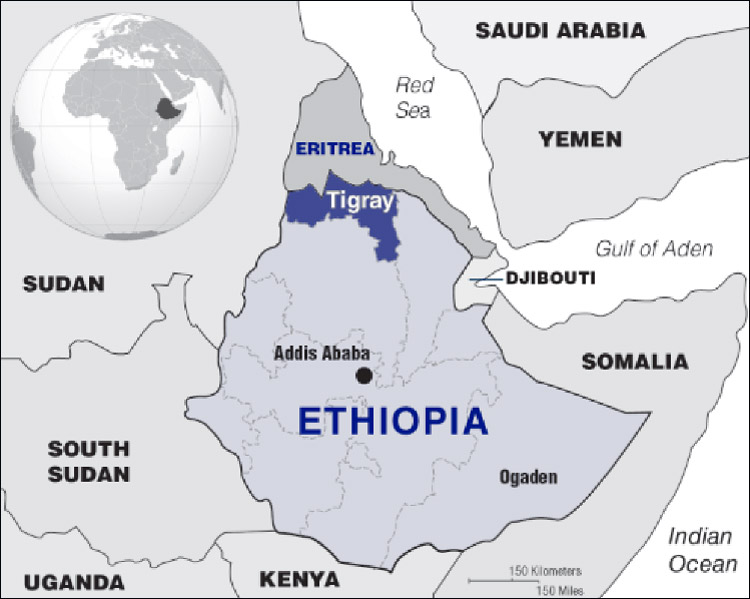After two weeks of bloody military conflict that has already displaced thousands of civilian refugees, Ethiopian Prime Minister Abiy Ahmed announced a “final” offensive Nov. 17 against the Tigray People’s Liberation Front that rules in the country’s northern Tigray state. The fighting threatens a broader civil war, which could fuel instabilities across Ethiopia and in other countries of the strategically important Horn of Africa at the mouth of the Red Sea.
The war comes after two years of mounting tensions as the TPLF, based among a small minority of Ethiopia’s people but long dominant in the country’s politics, clashed with the Abiy government’s drive to unify Ethiopia and exploit the impoverished country’s developing capitalist economy. In particular, the TPLF leaders refused to go along with Abiy’s efforts to forge a centralized party out of the ethnic-based coalition that has governed Ethiopia for the past three decades.
Airstrikes and a ground offensive were launched by the Ethiopian military against the TPLF after Abiy claimed it had “crossed the last red line” by attacking a federal military base and seizing heavy weapons Nov. 4. Federal forces claim to have made significant inroads into Tigray.
The Ethiopian military said it carried out “surgical air operations” Nov. 17 on military targets outside the Tigray capital Mekelle. The TPLF said a dam and a sugar plant had been hit and there had been civilian casualties. Tigray TV showed damage in residential areas of the city.
The Tigray rulers announced a state of emergency and retaliated with rocket attacks, including across the border hitting the airport in Asmara, the Eritrean capital.
The TPLF claims Eritrean tanks and soldiers have crossed the border, which runs through disputed territory. Abiy had won the Nobel Peace Prize last year for negotiating the end to decades of fighting and tensions between Ethiopia and Eritrea, largely along the Tigray-Eritrea border.
Hundreds of fighters have been killed in the current battles. Civilian casualties are disputed, but over 30,000 refugees have already fled to neighboring Sudan. “Scores, likely hundreds” of day laborers resident in southwestern Tigray, mainly ethnically Amhara, were “stabbed or hacked to death” with machetes Nov. 12, Amnesty International reported. Abiy claimed the massacre was carried out by TPLF forces, but this was denied by the Tigray rulers.
The Ethiopian government says the TPLF is “endangering the country’s existence,” and appointed its own new head of the Tigray region Nov. 13. It issued arrest warrants for the current officials there.
Colonial intervention in the region
Ethiopia was one of only two African countries that successfully resisted colonization by the British, French, Italian and other European powers when they carved up the continent. But as one of the most diverse countries in Africa, it has numerous tribal divisions and over 100 languages.
The TPLF led an insurgent coalition of ethnically based liberation fronts to take power in 1991. The broad front ousted the military regime that had ruled Ethiopia since 1974 when it overthrew the Washington-backed Emperor Haile Selassie.
Alarmed at the revolutionary overthrow of Selassie, and its impact on U.S. imperialism’s growing sway over the region, Washington pressured the neighboring Somali regime to invade Ethiopia’s Ogaden region in 1977-78. They hoped to topple the new regime, which sought and received help from revolutionary Cuba. With this aid, Ethiopia defeated the invasion.
As part of the coalition that overthrew the military regime in 1991, the Eritrean Peoples’ Liberation Front won Eritrea’s independence from Ethiopia.
Over time, layers of landlords and capitalists in Ethiopia used the ethnic divisions of different language groupings as distinct bases of support while profiting from exploiting the peasants and workers. The federated state of Ethiopia is based on nine self-governing ethnic territories reflecting these divisions.
Despite Tigray only having about 5 million of the country’s 116 million people, the Tigray front leadership dominated the coalition, as well as the government and the military, for almost three decades.
In 2018 a monthslong popular revolt targeting the dominance of the TPLF forced the resignation of the government. Abiy, from the Oromo, the country’s largest ethnic group, promised to unify and develop the country. He led the new ruling coalition.
He freed political prisoners, lifted the ban on opposition political parties and ended the longstanding state of emergency.
Abiy moves to centralize power
After having purged many Tigray officials, Abiy dissolved the governing coalition last year. His goal was a top-down merger into a single national nonethnic party, the Prosperity Party, which the TPLF refused to join. He has increasingly cracked down on political rights.
While Ethiopia remains one of the poorest countries in Africa with a yearly per capita income of $850, it is today one of the fastest growing. Abiy sought to accelerate this development by opening up to foreign capitalist investment. Billions of dollars of financing in ports, rail, airports, agriculture and education poured in from the Gulf states, Saudi Arabia, China, Turkey and the U.S.
In particular, significant natural gas resources have been discovered in the Ogaden, and both Beijing and Ankara have invested heavily in their development.
Beijing’s investment and loans in Ethiopia have reached more than double that of the U.S. rulers, in what has been one of Washington’s main allies in the area. These rivalries play a role in the country’s political divisions.
The prospect of the war spiraling out of control has raised alarm throughout the region among the competing capitalist investors. Attempts to intervene with offers of “mediation” by various imperialist and other African powers have been resisted by both sides.


